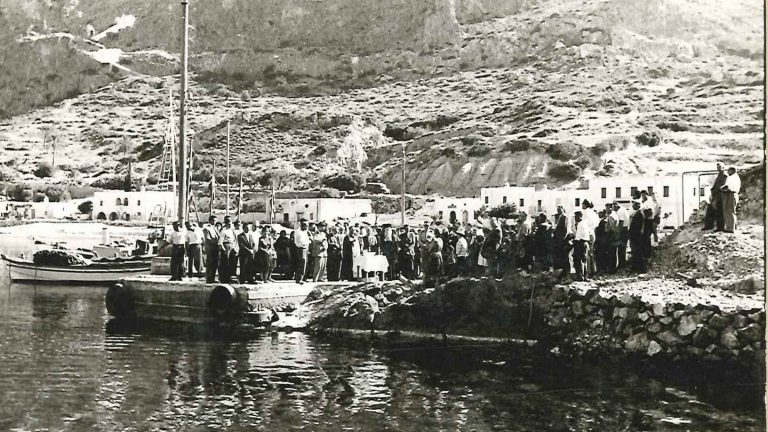An overview of the Teams projects and activities from 1960 until 1971 with the work of he Dutch Team from the World Council of Churches (Wereldraad van Kerken) at the Greek island of Kythera (1) and an financial overview (2).
This document is mainly in English, and only partly in Dutch (3) and any contribution from you is welcome.
Collecting of this information was started November 2004 by Jean Bingen.
Copies of this 1st document (in 2005) were handed to Mrs. Eleni Charou-Koronaios in Chora at the Kastro to be kept in the small historical island archive office. Eventually this document and all digitalized pertaining information on the activities of the Team will be handed over to be kept in the island archive, the Bibliotheca in Kondolianika.
The late Bishop Meletios Galanopoulou issued in 1958 a request for “technical assistance” to the World Council of Churches in Geneva. The Bishop’s main goal was to improve living conditions for the island people.
In July 1959 Mr. J.M. Koksma, civil and architectural engineer, arrived from Holland at Kythera for an investigation for a “community development” of the island and together with Bishop Meletios a program for the team’s activities was developed.
1 The actual team’s activities were from May 1960 thru September 1971:
Jurjen (“George”) Marten Koksma Ing., architect and civil engineer, Dutch nationality, director. Born 27th of August 1907, died at Kythera 26th of November 2004. Office in Chora, opposite the Mercator market.
Anna Jacoba Koksma-Lagendijk, secretary and treasurer, Dutch nationality. Born 4th of March 1911, died at Kythera 19th of December 1993.
George and Anna Koksma were married the 16th of May 1934. They had one daughter born in 1937. They are both buried at the cemetery of Agia Anastasia on the road from Potamos to Karavas.
Throughout the years many persons and supervising boards or committees in Switzerland (Geneva), Greece (Athens) and Holland (Utrecht) were involved with the Team’s activities.
Regularly work reports in English, in the period May 1960 thru September 1971, were made and sent all over the world to those concerned with the progress of the Team’s programmed projects:
- reforestation (herbebossing)
- watereconomy (regeling v/d waterhuishouding)
- roads and harbours (wegenbouw en havens)
- animal husbandry (veeteelt- voorlichting)
- education (onderwijs, oprichten van opleidingen)
- religious themes (kerk- en zondagsschoolactiviteiten)
- industry (bevordering van de nijverheid)
- social welfare (maatschappelijke zorg)
- agricultural reform (landbouwhervormingsprojecten)
- technical assistance (technische assistentie)
- promotion of tourism (bevordering van toerisme)
Missing reports are from the period 10 June 1962 thru June 1964. All retrieved work reports are scanned. Main topics of bi-weekly reports (May 1960 – June 1962) and monthly reports (July 1964 – September 1971) are in Word.

Over the years many technical assistants strengthened the team:
Mr. W. Spliethoff Ing., teacher at the Technical College Arnhem (Technische Hogeschool), who had met Mr. Koksma at an Inter Church meeting in March 1961, took the idea of sending students for their work experience to Kythera, Greece, to the Board of Directors of the school. The Technical College Arnhem adopted this development project at Kythera from 1962 through 1967.
Following students, civil engineering and or architectural, have been sent to the island from approx the end of January to the midst of July or August:
1962 Jean Bingen, Erik Boekaar, Wessel Breunisse, Martin Klerkx
1963 Jan Hakfoort, Jan Willems, Cees van Dingstee and Wim Leenders
1964 Gerard Helmink, Wim Rijnberk
1965 Bob Scholten, Hans de Kinkelder
1966 Anton Obdam, Lex Pannekoek, Jan Stappers
1967 Frank Berghuijs, Harry Wellink
Click here for more amazing island photos in 1966
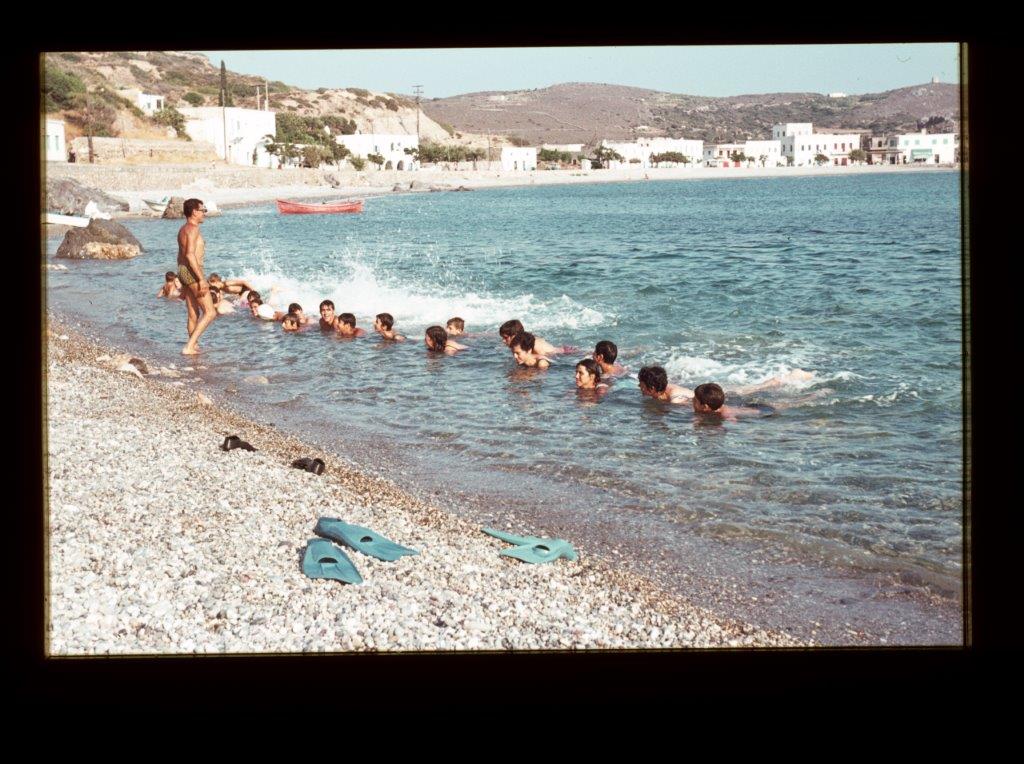
Also
1960 July 22 – 1961 September Charley Schroeder from the USA, he taught the governmental forester Yannis Zerlendes to drive the Team’s Jeep to get the tree planting (reforestation) started (the Bishop gave the gardens of Myrtidia and asked for seeds from the authorities and grammar school children acted as the first labourers): Charles Schroeder (born 1934) from Minnesota, USA, was before he came to Kythera in charge of animal husbandry for Inter-Church Service in Greek Villages in Katsika near Ioannina. At Kythera he worked with old Dr. Kassapis, as his interpreter, on a sociological review of the island
1960 Frits v.d. Hoeven from Holland, just having finished gymnasium. Worked with the team on a sociological review of the island from end September thru early December
1961 Keimpe Jellema from Holland, architectural engineer. At Kythera from October 1961 to mid of July 1962.
1962 – 1964 Dave Vijsma from Holland, architectural designer, as from 11 Oct ’62 to Oct ‘64. (Returned later as a physiotherapist for some time to the island) CJV, het ‘Christelijk Jongeren Verbond’, (Christian Youth Covenant)
1964 September – 1965 January Eddy Stevens from Holland, 17 years old trainee electrical from Technical School Hengelo, Holland
1965 Marinus Rutgers from Holland, January 11 – June 12
1965 early July to mid August 1966 Jean Bingen from Holland, civil engineer
1966 Tom Klinkhamer from Holland, end of the year 3 months, partly in Potamos (working for the reforestation project) and Livadi (water supply)
1967 May to end of year 1967 Wessel Breunisse from Holland, civil engineer, accompanied by his wife Tilleke and their 2 young children.
1967 Jan Stappers from Holland, civil engineer, from August until last part of the year (he was also a representative of the “Kythera Vriendenkring Nederland”)
1969 July until August 1971 Piet C. Goozen from Holland, civil engineer, supervised the work in Mylopotamos (local civil contractors Nassos Megaloconimos from Pitsianika and Kosmas Karidis van Kato Chora started in February 1970); in August 1970 also arrived his fiancée Anke de Rooij, school teacher, to help Mrs. Koksma with the administration for the domestic school in Mylopotamos. In the end she also prepared the rebar bending schedules! They left together in August 1971.
1970 2 students from Technical University Eindhoven, Holland, in July during the vacation of Piet Goozen.
Furthermore:
Mrs. Ir. Ida Blok from Holland, agricultural engineer from Wageningen University, end of February 1967 until end of February 1969
Walther Kupferschmid from Switzerland, architectural engineer, 14 January 1965- September 1965, Mylopotamos School, lived in Potamos
Hans-Peter Jann from Switzerland, agricultural, 21 October 1964- thru April 1966, worked at a farm in Paleopolis and in the experimental garden at Agia Anastasia
Chris-Paul Stapels from Holland (and his co-worker Hugo Post), photographer and filmmaker, visited the island in the summers of 1965, 1966 and 1967. He came to the island on request of … to provide this organization with publicity material to support fund raising actions for the Team’s various projects.
**Meet the Kytherians in the 1960’s, photos by Chris Paul Stapels
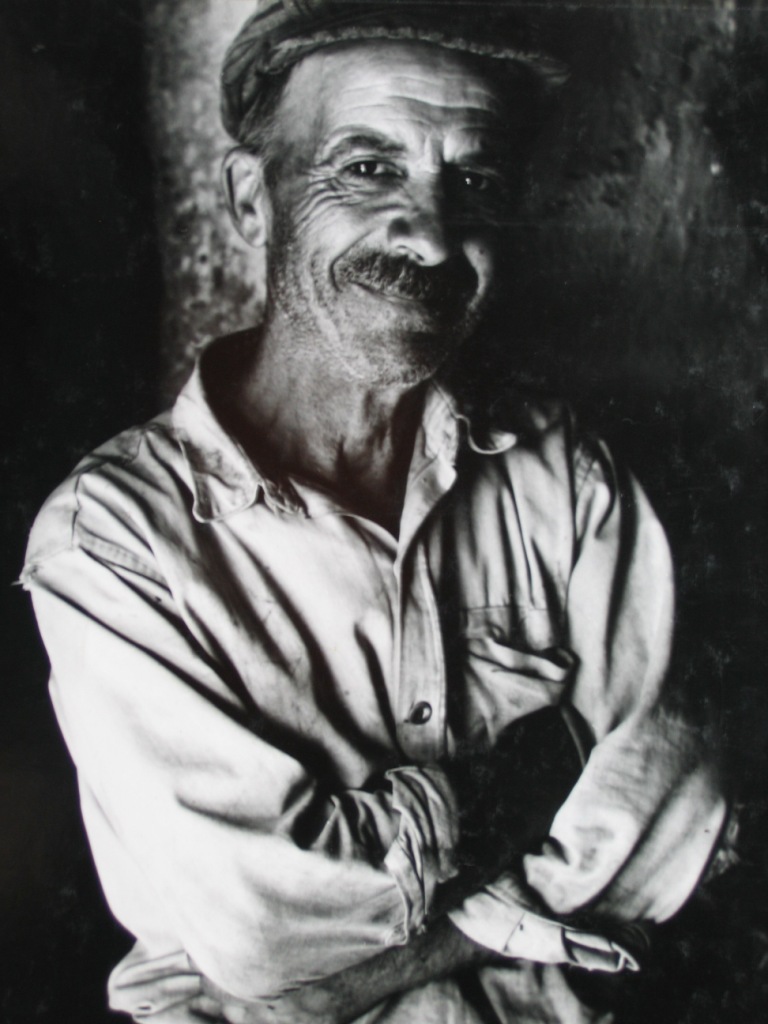
Island helpers:
Demos Tzanidis, March 1961 – 19 January 1962, 1st bulldozer driver (this bulldozer was donated by “Brot für die Welt”)
Georgios Souris 2nd bulldozer driver as of 22 January 1962 and 1st air hammer driver (this air-hammer was also donated by “Brot für die Welt”)
Stefanos from Chora, 3rd driver working many years with the bulldozer
Panayiotis Kassimatis (o Psilos), from Frilingianika, working many years with the air hammer-compressor
Irini Gianniotis from Kato Livadi, 1st aid of Mrs. Koksma, 1962
Dimitra Kypriotou-Veneris from Chora, 1st aid of Mrs. Koksma, as from 1963 until end of 1971. Later on, also for many years at Agia Anastasia (in total 18 years as of 1963!).
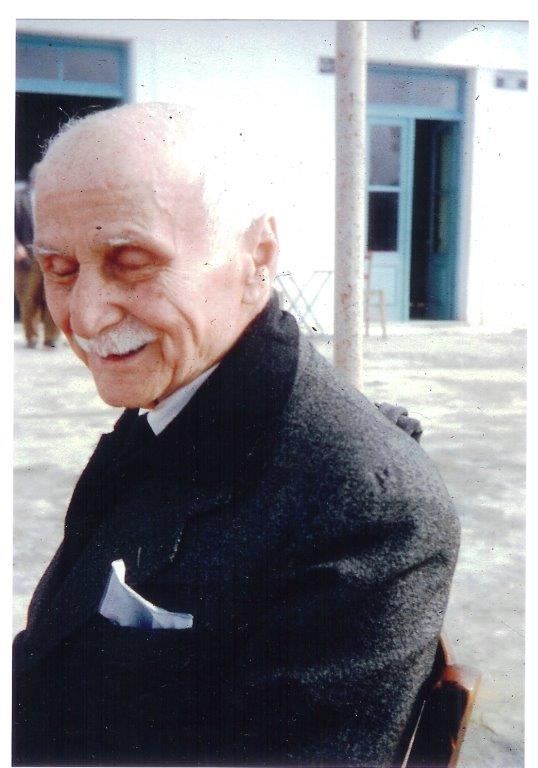
Larger civil works and conceptual designs to be remembered (list below is not complete, over 20 stables, many houses, rural road building etc. are not mentioned):
1961: roofing structure market place at Potamos, designed July 1961, constructed in 1962.
1962: community water supply in 3 villages: Potamos, Logothetianika, Karavas/Diakopoulianika.
Survey and construction for the 1st extension of the landing stage at Kapsali.
Topographical survey of Livadi for a future community water supply system.
Early in the year a topographical survey was made of a larger part of Kapsali for a large hotel plan; at the proposed site is now situated, in a small forest, the camping of Kapsali. According Mr. Vironas Dapontes these trees came from his tree nursery at Vroulea.
Conceptual plans for an old people’s home at Potamos and Chora
1963: conceptual design of bridge at Diakofti for future harbour plans
1964: start of construction for the domestic school for girls in Mylopotamos by 2 ecumenical youth summer camps from Holland
1965: start of topographical survey for future airstrip at Amoutses, Frilingianika, a conceptual plan was made.
First stone laid the 3rd of October and part of foundation poured for the old people’s home in Potamos. In a later year earthquake design and construction drawings were (re)done by the Greek civil engineer Mr. Prineas from Athens. The old people’s home was officially opened 17-08-1975!!
1966: community water supply system for Livadi.
Restart of topographical survey for future airstrip at Frilingianika
A community water supply tank for Avlemona
Start of Artesian well drillings
Foundation for new church in Diakofti
1967: survey of Fratsia for a community water supply system
Start construction of cheese factory at Fratsia.
Design and construction of “harbour restaurant” at Kapsali landing stage.
Civil contractor Karamitzas from Athens started in July the construction of the old peoples home in Potamos.
Topographical survey Koksma’s experimental garden at Agia Anastasia
1968: community water supply at Fratsia and cheese factory finished
1969: community building in Chora (design was started January 1961!)
1970: in February the civil contract was let to local contractors to finish the domestic school in Mylopotamos
1971 24th of September, opening of the domestic school for girls in Mylopotamos
(Dec. 1971 first 18 seat passenger airplane from Athens arrives at Kythira Airport)
(1972 in Kalamos water supply pipes came available for installation)
Kythera Vriendenkring Nederland.
Very important to the Team became the founding of the “Kythera Vriendenkring Nederland” (Kythera Circle of Friends The Netherlands) in the Dutch town of Vlaardingen in February 1967.
Main founder an editor of their periodical was Dr. Gerard Hornstra who together with his wife Netty Hornstra-de Boer had been to Kythera the previous year to start the realisation of the Livadi community water supply. This “circle of friends” at one time had some 400 registered members and informed its members about the plans and achievements of the WCC team at Kythera by means of their periodical “IRIS” until the end of 1971. The K.V.N. members all over Holland organized many fund-raising drives to provide the WCC team at Kythera with funds for a variety of projects.
Mr. and Mrs. Hornstra came to Kythera for their first time in June 1966. Together with Ds. Krol they were leading the first summer work camp from Vlaardingen, Holland, to start the community water supply in Livadi. For this project already as of 1965 all kinds of fund raisings activities had been organized by ecumenical youth from Vlaardingen. They had collected enough money to buy the plastic pipes from the Dutch firm Wavin, the same company that had supplied the pipes for the 3 projects in 1962. Two groups of these youngsters came to Kythera in June and July to start the foundation of the water tank and too dig the required deep trenches in the hard soil. Several companies in Vlaardingen supplied the money to buy the required electrical pumps. These were to pump available well water into the water tank situated on a high enough hill side. Electricity for the pumps was supplied some years later by the junta.
Ecumenical summer work camps, largely organized by “De Oecumenische Jeugdraad” in Utrecht, Holland.
A list of many participants, but not all, is available.
1960: international camp at Myrtidia from 4 August to 1 September, organized by the WCC Athens office; placing of fencing to protect the proposed tree planting in Myrtidia, painting of the Potamos hospital furniture, preparing a foundation for a water retaining dam at Mitata. Young people from Kythera participated in the kitchen.
1964: school Mylopotamos 2 camps. Early July they started the excavation for the water basin, column footings and foundation beams, poured part of the foundation beams and part of the prefab slabs for the ground floor). The 2nd camp continued this work from 26/7 to 20/8. (Hans van Oosterom wrote “Wij op Kythera”, a humoristic daily work diary)
1965: Seconu (Swiss organisation run by W. Kupferschmid’s sister) continuous international camps: 10 June/July/17 Aug school Mylopotamos. Technical supervision was by Walter Kupferschmid and Bob Scholten.
1965: from 15/7 to 10/8 irrigation project Paleopolis, digging a large and deep well in dry riverbed 1500 m inland. In October 1965 due to torrential rainfall all work was destroyed by the river. Technical supervision was by Jean Bingen. (List of participants is available)
1966: school Mylopotamos 2 camps, 1st camp from 2 to 27 July, the 2nd from 26 July to 17 August; continuation of prefabrication of concrete floor members. Technical supervision by Bob Scholten (who came for a period of 6 weeks from Holland after having finished his technical studies) and Jan Stappers (For the 2nd camp a list of participants is partly available)
1966: community water supply Livadi 2 camps. The 1st camp was from 16 June to 6 July, the 2nd camp from 6 July to 26 July. These camps were organized by ecumenical youth from Vlaardingen, a town in Holland. Technical supervision of the work camps was by Anton Obdam, Lex Pannekoek and Jan Stappers (first camp only). Overall technical supervision and coordination with local authority was by Jean Bingen (For the 2nd camp a list of participants is available).
1967: in July, from 7 to 26, cheese factory in Fratsia, excavations and pouring foundation for the ‘cold cellar’, by youths from ‘s Hertogenbosch, Holland This camp was organized via ‘Kythera Vriendenkring Nederland’. Technical supervision of the work was by Harry Wellink
1967: in July, from 7 to 26, at Mylopotamos, digging of holes as preparation for the tree planting camp that would arrive early February in 1968, also partly digging of trenches for the community water supply and installing left over prefabricated floor members of last year for the domestic school. Technical supervision for this work camp was by Frank Berghuijs. Overall technical supervision work camps by Wessel Breunisse,
1967 a 3rd summer work camp arrived at Mylopotamos, as from 27 July to 17 August, digging trenches for water supply
1968: 1st winter camp (!), from 1 to 28 February, in Myrtidia, by ecumenical “West-Friese” youngsters, from Holland, organized via Kythera Vriendenkring Nederland: tree planting in Myrtidia and near Dokana. Technical supervision by Ida Blok (list of participants is available).
1968: 2 summer camps, one for the construction of concreted roads in Livadi for 3 weeks in July, and one for a community water supply in Fratsia, from mid July to 9 August (by governmental orders Fratsia was chosen in stead of Platia Ammos beach, near Karavas, for which village also a survey was available), also a finishing touch of pavement around the cheese factory. Technical supervision in Fratsia was by Frank (and Riet) Berghuijs (Frank came to Kythera on vacation!). They both also laid plastic sewer pipes at the Agia Moni monastery (list of participants is available).
1969: in June Mrs. Koksma organized the elementary school in Mylopotamos for accommodation for a work camp. During 3 weeks in July they excavated trenches for the sanitary sewer system for the rural school for girls.

2 Financial Overview
1968 (click on the photo to enlarge
Financial overview 1974 en 1998 scroll down
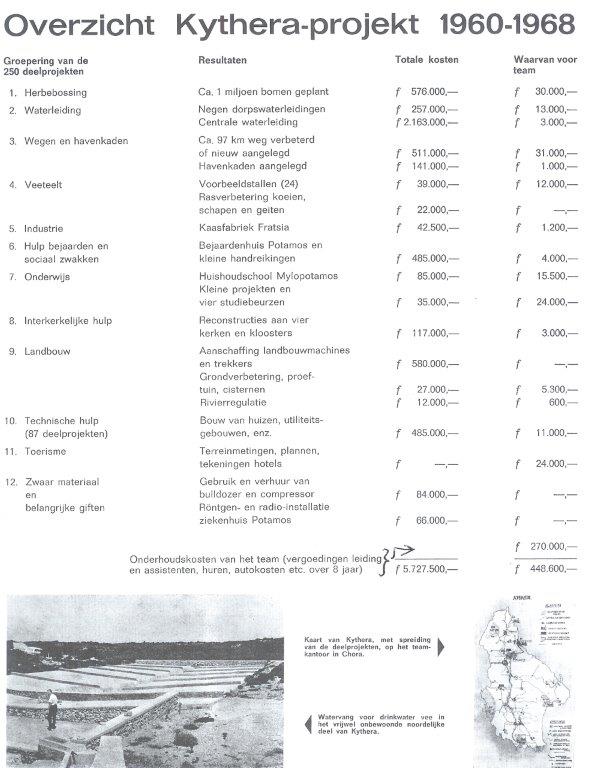
a financial overview by J.M. Koksma in 1974
Cost in drachms to value of the years 1960 to 1971
(In Word by Jean Bingen, October 2011)
| Period | Program chapter | Instigator(s) | Donations
Support from Non-Greeks |
Participation of
inhabitants |
Funds from
Greek Government |
Team’s
cost |
Results | Remarks |
| 1960
to 1969 and on |
1.Reforestation | Team and
Bishop |
England
1.590.000 America 250.000 Holland 385.000 |
1.100.000 | 7.380.000 | 300.000 | More than 1.000.000 trees planted | |
| 1960
to 1969
’65 -’69 |
2. Water economy
a) water systems in 9 village conglomerates b) irrigation c) control system |
95% by Team
a) 5% by inhabitants b) Inhabitants c) Team |
Holland
2.690.000 Diverse 150.000 — |
390.000
150.000 — |
1.395.000
200.000 28.000.000 |
128.000
10.000 35.000 |
Total length:
24.000 metres
— 65.000 metres |
Design, calculations and an important part of execution by Team
— Governmental with Team’s cooperation |
| 1960
to 1969
|
3. Connections
a) New roads
b) Harbour works
c) Road cover |
78 % inhabitants 22% Team 64 % inhabitants 36% Team 75 % inhabitants 25% Team |
330.000
1.468.000
1.100.000 |
360.000
290.000
600.000 |
636.500
1.660.000
4.800.000 |
386.500
19.000
70.000 |
a) 100 km rural roads made by Team’s equipm’t
b) 365 m quay wall c) 120 km asphalt or concrete |
|
| 1962 to 1969
’61 -’64 |
4. Animal husbandry
a) stable building
b) race improvement |
Team and inhabitants
Team and inhabitants |
America & England
244.000 America 450.000 |
196.000 |
150.000
— |
35 stables
800 strong race animals |
Design and control by Team |
|
|
1964 to 1969 ’67 -’69 |
5. Industry
a) cheese factory
b) canning |
Team & inhabitants Team |
Holland 526.500 Germany 300.000 |
27.500
3.000 |
25.000
4.500 |
Ready in 1968
In several villages |
Design & construction by Team |
|
| Period | Program chapter | Instigator(s) | Donations
Support from Non-Greeks |
Participation of
inhabitants |
Funds from
Greek Government |
Team’s
cost |
Results | Remarks |
| 1960 to 1967
’61 -’68 |
6. Social Care
a) support and stimulant
b) old people’s home |
Bishop
& Team |
Diverse
35.000 & 4.000 Australia 5.000.000 |
a) 19.000
18.000
b) 30.000 |
Private financier took over. Not ready in 1974 |
(opened in 1975) |
||
|
1960 to 1969 1961 to 1971
|
7. Education
a) diverse
b) agricultural and home economics boarding school for girls |
a) Diverse
b) Team |
56.000
America 180.000 Diverse 1.200.000 Holland 3.800.000 |
25.000
20.000 |
145.000 |
358.000
252.000 |
Centralization from 10 to 5 schools
b) Ready by end of 1971 |
|
| 1960 to 1969
|
8. Religious themes
diverse |
Bishop & inhabitants | From all over the world approx 1.000.000 | 350.000 | 24.500 | Many restorations under Team’s supervision | ||
| 1960 to 1969 | 9. Agricultural reform | 50% Team
50% inhabitants |
2.560.000 | 2.124.000 | 3.900.000 | 48.000 | Much mechanisation | |
| 1960 to 1969 | 10. Technical assistance | Diverse | 2.200.000 | 2.300.000 | 2.500.000 | 120.000 | Houses and infrastructure | Team acted many times as adviser |
| 1960 to 1969 | 11. Tourism | Diverse | 250.000 | A constant propaganda by team | ||||
| 1962 onwards
|
12. Heavy equipment | Team | Germany
2.200.000 England 2.800.000 |
Bulldozer
Air compressor X-ray installation |
||||
| General maintenance of Team | 2.200.000 |
WCC Team Kythera
A financial overview 12-year period 1960 – 1971 in Dutch text
Compiled by J.M. Koksma in 1998
(project numbering as according Team’s program and monthly reports is by Jean Bingen, February 2008)
- reforestation (herbebossing)
- water economy (regeling v/d waterhuishouding)
- roads and harbours (wegenbouw en havens)
- animal husbandry (veeteelt en voorlichting)
- education (onderwijs, oprichten van opleidingen)
- religious themes (kerk- en zondagsschoolactiviteiten)
- industry (bevordering van de nijverheid)
- social welfare (maatschappelijke zorg)
- agricultural reform (landbouwhervormingsprojecten)
- technical assistance (technische assistentie)
- promotion of tourism (bevordering van toerisme)
| Project no. | Projecten | Donaties ontvangen door het WCC Team
Donations received by Team |
Participatie v/d
Inwoners Participation inhabitants |
Participatie v/d
Griekse overheid Participation of the Greek government |
Bijdragen v/h
WCC Team Contributions by Team |
Totaal per project door WCC
Total per project by WCC |
| Griekse drachme | Griekse drachme | Griekse drachme | Griekse drachme | Griekse drachme | ||
| 1 | Herbebossing (ca 2.000.000 bomen)
Reforestation |
2.210.000 | 1.100.000 | 7.380.000 | 300.000 | 2.510.000 |
| 2a | Waterleiding in (7) dorpen
Water supply in 7 villages |
2.690.000 | 390.000 | 1.359.000 | 128.000 | 2.818.000 |
| 2b | Irrigatie
Irrigation |
150.000 | 150.000 | 200.000 | 10.000 | 160.000 |
| 2c | Centraal waterleidingnet
Central water supply system |
– | – | 28.000.000 | 35.000 | 35.000 |
| 3a | (lokale) wegenbouw
Local road construction |
350.000 | 360.000 | 636.500 | 386.500 | 736.500 |
| 3b | Wegenverharding
Road paving |
1.100.000 | 600.000 | 4.800.000 | 70.000 | 1.170.000 |
| 3c | Havens (Kapsali, Agia Pelagia, Platia Ammos)
Harbors |
1.468.000 | 290.000 | 1.660.000 | 19.000 | 1.487.000 |
| 4a | Stallen (ca. 25)
Stables |
244.000 | 196.000 | 150.000 | 394.000 | |
| 4b | Rasverbetering, koeien, schapen, geiten
Stock improvement cows, sheep, goats |
450.000 | 450.000 | |||
| 5 | Opleidingen: Mylopotamos huishoudschool, aantal kleine proj. + 4 studiebeurzen
Education: Mylopotamos rural school, several small projects, 4 scholarships |
5.180.000 | 20.000 | 5.180.000 | ||
| 6 | Religieuze onderwerpen
Religious subjects |
1.000.000 | 350.000 | 24.500 | 1.024.500 | |
| 7a | Kaasfabriek Fratsia
Cheese factory |
526.500 | 27.500 | 25.000 | 551.500 | |
| 7b | Inblikken (fruit, groenten)
Canning (fruit, vegetables) |
300.000 | 3.000 | 4.500 | 304.500 | |
| 8a | Maatschappelijke zorg
Social wellfare |
3.900 | 19.000 | 37.000 | 40.900 | |
| 8b | Bejaardentehuis Potamos
Old people’s home |
5.000.000 | 30.000 | 5.030.000 | ||
| 9 | Landbouwhervorming
Agricultural reform |
2.560.000 | 2.124.000 | 3.900.000 | 48.000 | 2.608.000 |
| 10 | Technische assistentie
Technical assistance |
2.200.000 | 2.300.000 | 2.500.000 | 120.000 | 2.320.000 |
| 11 | Toerisme
Tourism |
250.000 | 250.000 | |||
| Diversen
Various |
56.000 | 56.000 | ||||
| ALLE | PROJECTEN | 25.488.400 | 7.929.500 | 50.435.500 | 1.637.500 | 27.125.900 |
| Dutch guilders | 8 dr. = 1 fl.,
At that time the coin of 30 dr. was US $ 1,- |
3,15 million | 0,95 million | 6,3 million | 0,2 million | 3,3 million |
COMPARISON
Overgenomen uit IRIS april 1968 van de Kythera Vriendenkring Nederland:
Bijdragen door:
– Gr. regering 4 miljoen gulden
– Inwoners Kythira 600.000 gulden
– Buitenland ca 1 miljoen gulden
– Team zelf 400.000 gulden
– Incl. 270.000 gulden voor kosten team, leiding, assistenten, woninghuur, onderhoud auto’s in 8 jaren (deze getallen ook genoemd in Werelddiakonaat uitgave mei 1969)
Copied from periodical IRIS April 1968, contributions from:
-Greek government 4 million Dutch guilders
-inhabitants Kythera fl. 600.000
-from abroad approx. 1 million Dutch guilders
-from Team fl. 400.000
-incl. fl. 270.000 cost of Team, supervision, assistants, housing rent, maintenance of cars for 8 years (figures also published in periodical Werelddiakonaat May 1969)
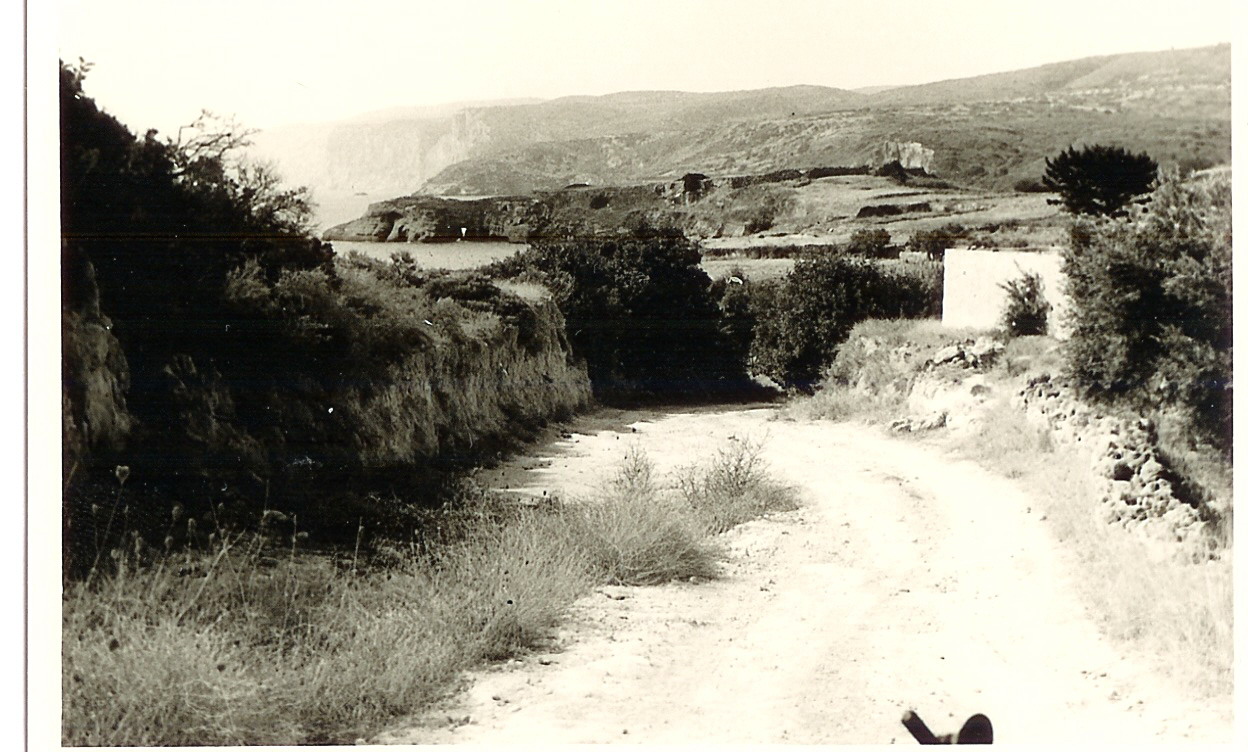
3 Dutch text only:
Chris-Paul Stapels (en medewerker Hugo Post), fotograaf en filmer bezocht het eiland in de zomers van 1965, 1966 en 1967. (Toenmalig laatste adres: Molenlaan 1 Voorschoten)
KVN.
Opgericht te Vlaardingen in 1967 de “Kythera Vriendenkring Nederland“. Contactorgaan “Iris”, verscheen 2 à 3 maal per jaar tot einde 1971. Drijvende kracht (eindredactie) was dhr. Dr. Gerard Hornstra samen met zijn echtgenote Netty. Hij had, in 1965, in Vlaardingen al veel werk gedaan voor het waterleidingproject in Livadi en zelf het eerste werkkamp in juni 1966 geleid (het tweede werkkamp stond onder leiding van o.a. dominee van Veen). Middels vele en diverse acties in geheel Nederland is zeer veel geld voor talloze projecten op Kythira ingezameld. De laatste IRIS uit 1971 geeft een gedeeltelijk overzicht in getallen van een aantal projecten. In 1998 (!) heeft dhr. Koksma een financieel overzicht over de gehele periode 1960 – 1971 opgesteld.
1970 wie waren de twee studenten van de TU Eindhoven (?) die Piet Goozen tijdens zijn vakantie in juli hebben waargenomen? Hadden zij ook van doen met de aardbevingsberekening voor de betonconstructie van de huishoudschool die door de TU Eindhoven zou zijn gemaakt?
Er zouden in totaal 20 (?) werkkampen met ongeveer 600 deelnemers op het eiland zijn geweest!
Mijn eigen telling komt niet verder dan 19 werkkampen met in totaal ongeveer 450 deelnemers.
Volgens mw. Anke Goozen-de Rooij zijn er in 1970 en 1971 geen werkkampen meer voor de school in Mylopotamos geweest.
Projecten en nummering van projecten en de gemaakte tekeningen:
Na het opheffen van het WCC team in oktober 1971, zijn alle resterende administratieve zaken, projectenboek en tekeningen opgeruimd (woorden van Jurjen Koksma vele jaren geleden). Zijn projectenboek van privé werkzaamheden na 1971, helaas zonder enige vermelding van jaartallen, evenals de ingekleurde tekening van Kythira met de status van de WCC projecten per eind 1965, heb ik nog in 2003 van Jurjen Koksma gekregen. Een latere tekening, gefotografeerd door Chris-Paul Stapels in 1966, laat extra het geplande vliegveld zien.
Een afschrift van een door Jurjen Koksma in 1974 in het Engels geschreven advies (Development Manifesto) betreffende ontwikkelingshulpprojecten gericht aan de Wereldraad van Kerken is in 2011 teruggevonden. In een aantal van zijn fotoalbums, is een beperkt fotografisch overzicht (met bijschriften) van een aantal jaren van de diverse activiteiten weergegeven.
Wie heeft (ook) nog oude (origineel met zonlicht afgedrukt) eerste tekeningen van deze projecten?
– Waterleidingprojecten (Potamos), Logothetianika, (Karavas), (Livadi), Fratsia, Mylopotamos, Kalamos.
– Huishoudschool Mylopotamos, fundatie bijna alles in prefab beton. Piet Goozen heeft in september en oktober 1969 nog aan de projecten 258 t/m 264 gewerkt. (Project 262 betrof ca 1 km kustweg vanaf Paleopolis richting Avlemona)
– Kaasfabriek Fratsia.
– Topografische meting van de proeftuin in Agia Anastasia, door Frank en Harry gemaakt in 1967. Gevonden in 2010.
– Topografische metingen t.b.v. vliegveld gemaakt in 1966 (Jan, Anton, Lex?), en al eerder in 1965 door Bob en Hans. Afdrukken van een landingsbaanontwerp door Koksma via Mr. Panayotis Samios uit Potamos in 2013 gekregen.
Vele vragen en opmerkingen:
– wat was de bemoeienis met de havenwerken van Platia Ammos, Agia Pelagia en Diakofti? Koksma had voor de brug van Diakofti een ontwerp gemaakt, project 75-3 tekeningnummer 125, gedateerd 18-2-1963, met een Grieks stempel. Dit is een tekening van één van de twee bouwkundige stagiaires (Cees van Dingstee) uit 1963.
– wat was precies de inbreng/bijdrage van het WCC-team bij de boomkwekerij in Myrtidia (1960) (see weekly reports May 1960 thru June 1962 and monthly report of July 1967), Agios Theodoros (in 1965 werden de werkers in deze kweektuin door het team betaald) en de verhuizing naar Kalamos, de kweektuin van de overheid, (zie foto Chris-Paul Stapels van 1966) aan het eind van 1965? In 1967 was de kweektuin weer terug in Agios Theodoros, in Kalamos was te weinig water. Kwamen hier de ca 2 miljoen bomen vandaan die tussen 1960 en 1972 op K. zijn geplant? Hoeveel bomen heeft Yannis Zerlendes voor de overheid bij Karavas geplant? Waar haalde Vironas Dapontes zijn bomen vandaan die hij in Vroulea heeft geplant? Vironas zegt (okt. 2005) een eigen bomenkweektuin (welke jaren?) in Vroulea te hebben gehad en dat ook de bomen boven Kapsali uit Vroulea kwamen. Waar en tot wanneer was er een bomenkweektuin in Karvounades? Volgens zeggen maar heel kort en op een locatie iets om de hoek bij de weg naar Keramoto.
– With aid of Miss Kapolla, domestic teacher from the government, preparations were made end 1967 for a pear cannery (and for other types of fruits and vegetables).
Hoe lang functioneerde het inblikken van peren in Karavas? (Ik heb samen met mijn vrouw eens een stuk of tien blikken van vakantie (1972, navragen in Karavas!) mee naar Nederland gebracht.)
– In augustus 2008 heb ik, uit de berging van Jurjen Koksma’s oude huis, van de nieuwe eigenaresse mevr. Hommine Pikros- Koksma, een doos vol “schrijverij” van Jurjen Koksma mogen ontvangen. Dit betrof in het Nederlands geschreven korte verhalen over gebeurtenissen op het eiland, wel en geen betrekking hebbend op de werkzaamheden van het team. Ook de in het Engels gestelde weekrapporten aan Geneve uit de periode mei 1960 tot juli 1962 en een gering aantal tekeningen van projecten en dia’s en zwart-wit negatieven kwamen tevoorschijn.
De korte verhalen vormden samen zijn “Hollandse Boek” en zijn door mij in 2009 op Cd-rom gezet, evenals de weekrapporten.
– In augustus 2010 heb ik wederom ordners met correspondentie en maandrapporten uit de periode augustus 1965 t/m eind 1971 gekregen.
– In april 2013 heb ik met een aantal aanvullende verhalen een Cd-rom gebrand genaamd ‘Het Hollandse Boek 2”.
– in januari t/m maart 2013 heb ik een zestal korte verhalen van Jurjen Koksma over “wonderen” bewerkstelligd door de icoon de Zwarte Madonna uit Myrtidia, in Word gezet en in een boekwerkje “Wonderlijke Vertellingen van Monaxía” afgedrukt.
– in oktober 2013 hebben we de overgebleven bibliotheek (vόόr het definitieve opruimen hiervan) van Jurjen Koksma doorzocht. Nog van belang zijnde boeken en/of documenten hebben we uitgezocht.
Toelichting op uitgevoerde landbouwkundige werkzaamheden door:
Ida Blok (mei 2005):
– je kunt me agricultural engineer noemen, was op Kythira van eind februari 1967 t/m eind februari 1969. Ik heb vooral veel tijd doorgebracht op de ‘proeftuin’, de tuin van de Koksma’s op Agia Anastasia. Verzorgde daar de boel en probeerde nieuwe dingen uit. Op de tuin in Agia Anastasia hadden we een vaste werknemer, Angelis, uit Potamos. Maar zijn achternaam heb ik niet. Ook aan de olijvenoogst en de druivenoogst in Paleopolis deed ik mee. Verder ben ik wel ‘de boer op’ geweest, hetzij uit eigen beweging hetzij op aanvraag; heb wat bemoeienis gehad met de kaasfabriek in Fratsia en ging zo nu en dan bij de boomkwekerij op Agios Theodoros langs.
– Wat de bomen en boomkwekerijen betreft, heb ik begrepen dat het als volgt in elkaar zat: De regering stuurde op een gegeven moment een bosbouwer, Yannis Zerlendes, naar het eiland. Maar hij kreeg geen geld mee om bomen te kunnen planten. Jurjen hoorde van de komst van Yannis, en vond herbebossing voor het eiland buitengewoon nuttig en nodig. En hij kon, bij de WCC, wel aan geld ervoor komen. En ik vermoed dat het Jurjen geweest is die bij de kerk (bij de bisschop) er op aangedrongen heeft grond ter beschikking te stellen. Zo is met financiële hulp van het team en de technische inbreng van Yannis de boomkwekerij en de herbebossing rond Myrtidia begonnen. Toen bleek dat alles goed ging en effect had, kreeg Yannis direct geld uit Athene. De jeep, een Willys, waarin Yannis ook wel reed, was van het WCC-team. Van de financiële zaken weet ik verder niets. De grond bij Aghios Theodoros voor de boomkwekerij hadden ze, volgens mij, van de kerk gekregen.
Ik ben er vrijwel zeker van dat alle op Kythira geplante bomen ook op Kythira opgekweekt zijn. Hoeveel dat er in totaal geweest zijn, en waar die allemaal geplant zijn, weet ik niet. Ik vermoed dat ook Vironas Dapontes zijn boompjes van Yannis betrok.
(Opmerking Jean Bingen: Op een getekende kaart van Kythira heeft Koksma eind 1965 ook de status van het bomenplant programma aangegeven. Vironas Dapontes heeft mij verteld dat de bomen voor Kapsali uit zijn kweektuin Vroulea kwamen. De in 1965 ingekleurde kaart bevindt zich nu bij mij in Maassluis. Een foto van Chris-Paul Stapels van een andere opgemerkte kaart geeft de status van een paar jaar later weer.)
